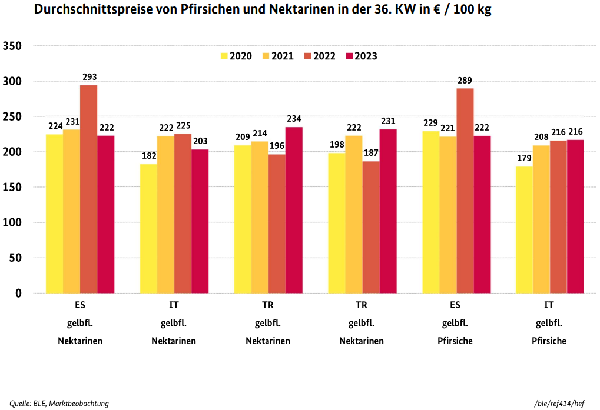The availability of peaches and nectarines had narrowed. In the case of peaches, Turkish offers had almost displaced Spanish offers from the top of the range. Deliveries from Italy and France completed the scene. In the nectarine segment, Spanish lots outweighed Italian ones. French shipments completed the scene. Greek batches also appeared in Berlin. Turkish fruit (see photo) rounded off the product range.
In Munich, these items from the mountainous region between Antalya and Side, which were very tasty, were still able to convince conditionally. The summery weather had improved the accommodation possibilities again, nevertheless a certain customer saturation was not to be denied. Some retailers ended the season without further ado and tried to get rid of their surpluses with the help of substantial discounts. In addition, the quality was no longer fully convincing in some cases, which is why sellers had to lower their demands.
Nevertheless, rising quotations could also be observed, triggered by the reduced supply. In Frankfurt, German fruit was still available: customers were expected to pay €16 per 3.75 kg package of white-fleshed peaches and per 3.6 kg package of yellow-fleshed peaches. Red vineyard peaches were also handled there at €16 per 3.5 kg carton. Domestic Paraguayos cost €3.20 per kg at Frankfurt.

Apples
The European campaign progressed, with early apples visibly losing importance. In contrast, the presence of Jonagold and Elstar expanded. Santana, popular with allergy sufferers, also gained in importance. The first Holstein Cox arrived and joined the already established Delbarestivale and Gravensteiner.
Pears
From Turkey came primarily Santa Maria. Supplies from Italy in the form of Santa Maria, Williams Christ and Carmen had increased overall. A wide range of pears was available from the domestic market: Williams Christ, Gute Luise, Clapps Liebling, Boscs Flaschenbirne, Conference and Forelle were some of the most popular varieties.
Table grapes
Turkish Sultana dominated; however, their increased presence caused perks in spots. Crimson Seedless of the same origin, meanwhile, increased in price in some places. From Italy, for example, came Victoria and Crimson Seedless in addition to Sugraone, Michele Palieri and Italia. But it was also possible to access various Arra varieties.
Plums
Local batches predominated, mainly Hauszwetschge, Presenta and Fellenberg were available. Various top varieties, Auerbacher and Ortenauer rounded off the range of goods. Stanley arrived from several Eastern European countries. The season is running, which can be seen from a quite friendly interest as well as from an extended availability.
Lemons
South African imports apparently predominated and were sometimes available in monopoly fashion. Spanish articles were scarce and played only a minor role. Argentine batches also appeared in Hamburg.
Bananas
Accommodations were not particularly strong. Interest could be satisfied without effort. For the most part, vendors had adjusted their supply to meet subdued demand, so they were able to confirm their previous demands.
Cauliflower
As a rule, domestic offers predominated, but in Frankfurt Belgian products played the leading role. On occasion, Polish and Dutch batches rounded out the marketing. The high temperatures had noticeably limited accommodation.
Lettuces
In lettuces, domestic batches predominated over Belgian batches. Almost everywhere, the prices of Belgian imports tended to be firmer, in some cases quite markedly so. In the case of iceberg lettuces, mainly domestic products were available, with Dutch products following in terms of importance. Here, as well as in the case of colorful lettuces, marketing was mixed.
Cucumbers
Domestic cucumbers in particular, as well as Dutch and Belgian snake cucumbers, apparently formed the basis of the assortment. Spanish offers, hardly noticed in the previous week due to their unappealing quality, were able to gain a foothold in Berlin at €5 per 12-pack.
Tomatoes
Dutch and Belgian deliveries dominated and were flanked by local fruit. Italian and Polish deliveries hardly went beyond a supplementary character. In addition, Morocco participated in the cherry tomato sector with 9x250 g trays. Availability had obviously diminished.
Sweet peppers
In addition to the dominating Dutch and Polish supplies, Turkish and Spanish offers could be accessed primarily. Belgian and domestic lots supplemented these. Hungarian red tomato peppers appeared in Munich, but were relatively expensive. Polish produce was generally much cheaper.
Source:BLE
